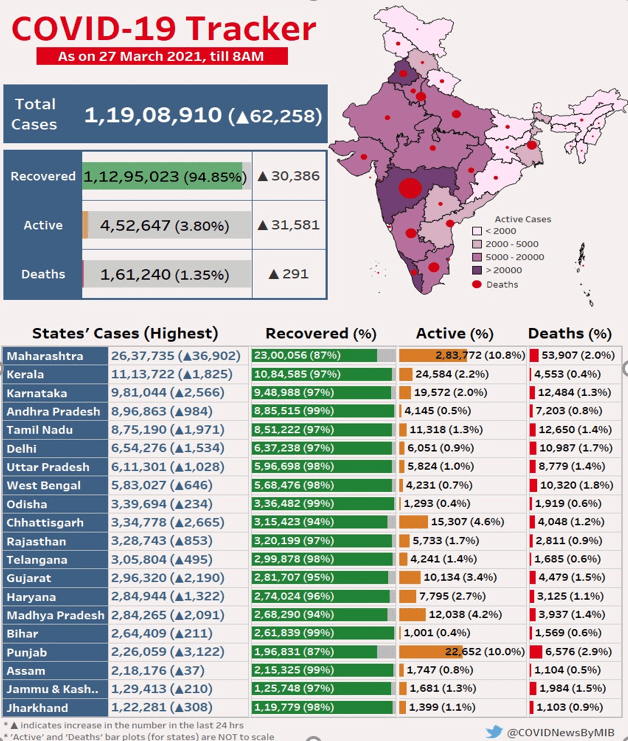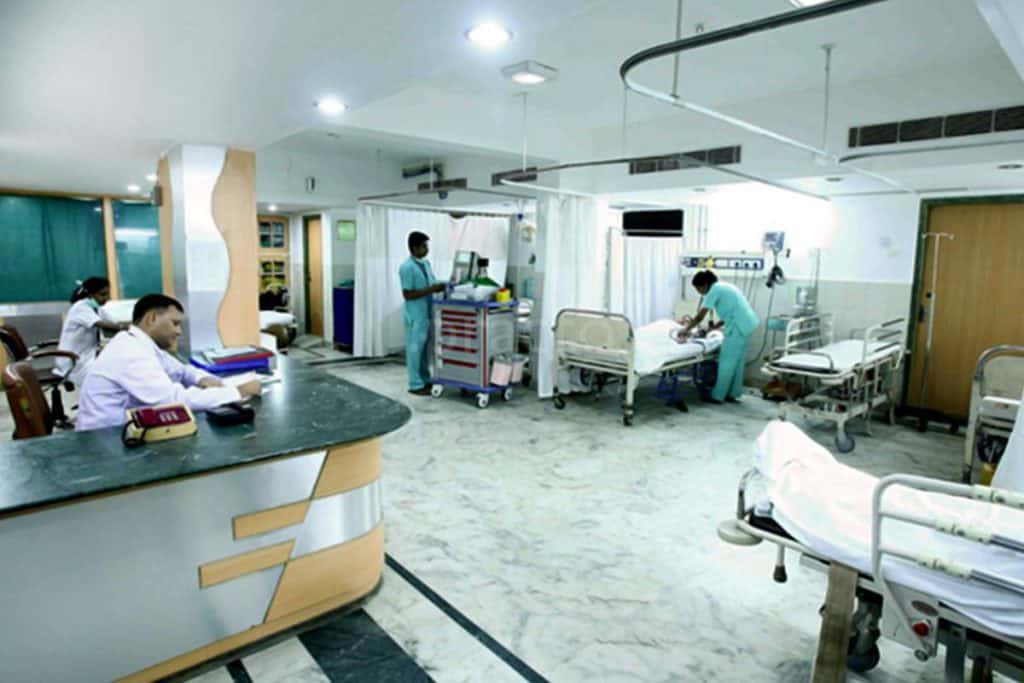“People have forgotten that the virus is still here,” says Dr Narendra Kumar Arora, member, National Covid Task Force. “They stopped wearing masks, or don’t wear them properly. They began to organise large social gatherings. It helped the virus spread,” causing a second country-wide wave of the COVID-19 infections, with daily cases crossing 50,000, for the first time since October last year. Worryingly, the second wave seems to be more widespread than the first one, with the number of daily cases rising sharply from a low of about 8600 a day in February first week to a new high of 59,118 new cases on March 26th.
Maharashtra and Punjab are contributing almost 70 percent of the new cases. In Punjab, 80 per cent samples of a total of 401 samples collected between January 1st and March 10th showed the presence of B.1.1.7 variant, a highly transmissible mutant which was first reported in the UK.
Besides, more than 200 cases of a double mutant (E484Q + L452R) virus, which means a combination of two mutations in one variant, has also been detected in Maharashtra, Delhi, Punjab, some other parts of the country. The E484Q mutation is capable of escaping body’s immunity and L452R mutation has greater infectivity. As research continues on the impact of these new mutations, the treatment protocol of those testing positive has not been changed.
What is causing this second wave in India?
Scientists are yet to confirm if these new variants are a reason for the second wave that India is now seeing. But experts are unanimous that people’s complacency and deviation from COVID-appropriate behaviour are important reasons for this new spike.
When the number of positive cases was on a decline till mid-February, experts put forward several theories, with some believing that the decline was because a major chunk of the Indian population had already been exposed to the virus, had asymptomatic COVID, and have recovered, resulting in their developing antibodies against the virus.
For instance, a sero survey by the Council of Scientific and Industrial Research (CSIR) in mid-2020 had tested the CSIR’s staff and their families — students, security guards, sanitation workers, housekeeping staff — across its 37 laboratories and centres for antibodies. This group had representatives from all socio-economic classes and people from varied cultures and demographies.
The survey findings, extrapolated to the entire population, suggested that the total number of cases in the country were probably in the range of 100 million, about 30 times the reported cases. The survey also stated that over 70% of people who had antibodies did not develop any symptoms. Also, 20% of people with asymptomatic infections may not have developed antibodies.
There were also other theories to explain the decline: genetics, BCG vaccination and earlier exposure to other coronaviruses protected the majority of Indians from Covid infection.
Read more: Struggling to book or reschedule a slot for the COVID vaccine? Read this
More virus mutations
But in recent weeks, media has been reporting a second wave in other countries, who were having difficulties in controlling this second wave. For instance, Manaus in Brazil, faced a rapid spread in January, just a few months after 76% of the population was found with antibodies.
“There could be several factors responsible for such a surge,” says Dr Anurag Aggarwal, director, IGIB, New Delhi. “It could be because the level of antibodies in the body had gone down with time or it could be a result of a new mutant causing the infections.”
But the most worrying aspect of this second wave, says Dr Arora, is the number of mutants being detected. “When a virus enters a person’s body, it multiplies and makes millions of copies of itself. And in the process, it mutates. These mutants can be less severe or more severe, less transmissible or more transmissible. But so many mutations can make the disease more severe. These mutants can also make the vaccines less effective,” adds Dr Arora.
The current spike in number of cases is also necessitating increasing hospitalisations across the country. Dr Himanshu Reddy, in-charge, COVID facility, King George Medical College, Lucknow, says that till 10-15 days back there were less than 10 patients admitted at a time in the facility. But there are now over 40 patients. “COVID-care has improved a lot compared to last year and they are more confident of handling severe cases, but the fact that this virus is highly transmissible, and spreads rapidly worries us,” adds Dr Himanshu. “Massive number of cases can overwhelm any healthcare system. We must avoid that situation”.
Is India prepared to tackle the second wave?
Last year, the government had set up massive COVID infrastructure, augmented existing facilities, allotted dedicated beds to tackle the rising number of cases. But soon after the numbers declined, it diverted these beds back to regular care.
“Last year, most hospital admissions were unnecessary,” says Dr Arora. “We have realized that mild to moderate cases can be quarantined and provided medical care at home. But if the need arises, we may have to again increase the beds for COVID patients. People need to understand that we can control the pandemic without increasing hospital beds. They must follow COVID-appropriate behaviour, before things go out of control. Besides, now we have vaccines to strengthen our fight against the disease”.
Read more: It isn’t over: Bengaluru’s fight and the pandemic
The vaccination drive launched on January 16th with a first phase target to inoculate three crore healthcare and frontline workers and others most vulnerable to infection has picked up pace and more categories of people can now get vaccinated. Despite concerns regarding vaccine availability and its safety and efficacy — India being the world’s largest producer of the vaccines does have an edge in its fight against COVID-19, say experts.
The government has now increased vaccination centres to 40,000, with a capacity to inoculate 80 lakh people every day. Over 5.5 crore people have so far received at least the first shot of the vaccine, but the country is far from meeting its target of inoculating 30 crore people by July. “Though we have been able to mitigate many myths and misconceptions around the safety and efficacy of vaccines, there is still a large number of people who are somehow apprehensive of taking it,” feels Dr Arora. “It could be because they are afraid of the needle, or side-effects of the vaccines. But I must emphasise that needle pain and side-effects are temporary and mild. But the disease can have severe and long-term implications on health”.
On an average, the country has administered 23 lakh doses in a day over the past week, with the private sector accounting for only 11-12 percent of this. Until March 27th, states across the country had used up only 54 million of the roughly 80 million doses distributed so far.
Follow these simple rules
While there is clearly a need to step up the vaccination drive, experts believe that pandemics cannot be controlled without people’s participation and contribution.
“Otherwise, the virus will keep coming back,” says Dr Arun Sharma, professor, community medicine, University College of Medical Sciences, Delhi. “People must remember how the virus affected the lives and livelihoods of millions across the country last year. All we have to do is to be a little more patient and keep following these simple rules—wear a mask, wash your hands, maintain six feet distance, and avoid crowds.
“And of course, take the vaccine when your turn comes and get tested if you feel you have come in contact with an infected person”.
Also read:

